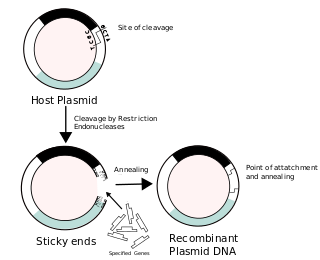Technology
- Compute DNA, a graphics processing unit (GPU) instruction set architecture (ISA) by Advanced Micro Devices (AMD) for data centers and supercomputers
CDNA, cDNA or C-DNA might stand for:
The Bioinformatic Harvester was a bioinformatic meta search engine created by the European Molecular Biology Laboratory and subsequently hosted and further developed by KIT Karlsruhe Institute of Technology for genes and protein-associated information. Harvester currently works for human, mouse, rat, zebrafish, drosophila and arabidopsis thaliana based information. Harvester cross-links >50 popular bioinformatic resources and allows cross searches. Harvester serves tens of thousands of pages every day to scientists and physicians. Since 2014 the service is down.

The 1960–61 European Cup was the sixth season of the European Cup, UEFA's premier club football tournament. The competition was won by Benfica, who beat Barcelona 3–2 in the final at Wankdorf Stadium in Bern, on 31 May 1961. It was the first time that five-time winners Real Madrid did not make it to the final, when they were knocked out by eventual first-time finalists Barcelona in the first round. Benfica was the first Portuguese team to reach the final and to win the tournament.
Genomic deoxyribonucleic acid is chromosomal DNA, in contrast to extra-chromosomal DNAs like plasmids. Most organisms have the same genomic DNA in every cell; however, only certain genes are active in each cell to allow for cell function and differentiation within the body. gDNA predominantly resides in the cell nucleus packed into dense chromosome structures. Chromatin refers to the combination of DNA and proteins that make up chromosomes. When a cell is not dividing, chromosomes exist as loosely packed chromatin mesh.

Vincent R. Racaniello is a Higgins Professor in the Department of Microbiology and Immunology at Columbia University's College of Physicians and Surgeons. He is a co-author of a textbook on virology, Principles of Virology.

Dual oxidase 2, also known as DUOX2 or ThOX2, is an enzyme that in humans is encoded by the DUOX2 gene. Dual oxidase is an enzyme that was first identified in the mammalian thyroid gland. In humans, two isoforms are found; hDUOX1 and hDUOX2. The protein location is not exclusive to thyroid tissue; hDUOX1 is prominent in airway epithelial cells and hDUOX2 in the salivary glands and gastrointestinal tract.

Carboxypeptidase N catalytic chain is an enzyme that in humans is encoded by the CPN1 gene.

Dual specificity protein phosphatase 7 is an enzyme that in humans is encoded by the DUSP7 gene.

Heparan sulfate glucosamine 3-O-sulfotransferase 3B1 is an enzyme that in humans is encoded by the HS3ST3B1 gene. Heparan sulfate biosynthetic enzymes are key components in generating myriad distinct heparan sulfate fine structures that carry out multiple biologic activities. The enzyme encoded by this gene is a member of the heparan sulfate biosynthetic enzyme family. It is a type II integral membrane protein and possesses heparan sulfate glucosaminyl 3-O-sulfotransferase activity ( HS3ST3A1). The Sulfotransferase domain of this enzyme is highly similar to the same domain of heparan sulfate D-glucosaminyl 3-O-sulfotransferase 3A1 and these two enzymes sulfate an identical disaccharide. This gene is widely expressed, with the most abundant expression in liver and placenta.

Heparan sulfate glucosamine 3-O-sulfotransferase 2 is an enzyme that in humans is encoded by the HS3ST2 gene.

Dehydrogenase/reductase SDR family member 4 is an enzyme that in humans is encoded by the DHRS4 gene.
The reverse northern blot is a method by which gene expression patterns may be analyzed by comparing isolated RNA molecules from a tester sample to samples in a control cDNA library. It is a variant of the northern blot in which the nucleic acid immobilized on a membrane is a collection of isolated DNA fragments rather than RNA, and the probe is RNA extracted from a tissue and radioactively labelled. A reverse northern blot can be used to profile expression levels of particular sets of RNA sequences in a tissue or to determine presence of a particular RNA sequence in a sample. Although DNA Microarrays and newer next-generation techniques have generally supplanted reverse northern blotting, it is still utilized today and provides a relatively cheap and easy means of defining expression of large sets of genes.
A random hexamer or random hexonucleotides are for various PCR applications such as rolling circle amplification to prime the DNA.
The 1956 season was Dinamo București's eighth season in Divizia A. As Romanian champions, Dinamo plays in the European Cup, becoming the first Romanian team to participate in this competition. In Divizia A, Dinamo ends second place, four points behind the champions. Alexandru Ene is also second in the goalscorer's hierarchy, with 17 goals.

Recombinant DNA (rDNA), or molecular cloning, is the process by which a single gene, or segment of DNA, is isolated and amplified. Recombinant DNA is also known as in vitro recombination. A cloning vector is a DNA molecule that carries foreign DNA into a host cell, where it replicates, producing many copies of itself along with the foreign DNA. There are many types of cloning vectors such as plasmids and phages. In order to carry out recombination between vector and the foreign DNA, it is necessary the vector and DNA to be cloned by digestion, ligase the foreign DNA into the vector with the enzyme DNA ligase. And DNA is inserted by introducing the DNA into bacteria cells by transformation.
The Bulgarian Basketball Cup is an annual cup competition, organized by the Bulgarian Basketball Federation since 1951. The cup was not held in 1957, 1958, 1960 and 1961. BC CSKA Sofia is the all-time record holder with 17 titles.

AMD Instinct is AMD's brand of professional GPUs. It replaced AMD's FirePro S brand in 2016. Compared to the Radeon brand of mainstream consumer/gamer products, the instinct product line is intended to accelerate deep learning, artificial neural network, and high-performance computing/GPGPU applications.
During the 1956–57 season, Red Star Belgrade participated in the 1956–57 Yugoslav First League, 1956–57 Yugoslav Cup, 1956 Mitropa Cup and 1956–57 European Cup.
The 1957 season marked the immediate return of Cherno More to the top flight of Bulgarian football after the club was dramatically relegated in 1955. The club started the season as SCNA Varna, Sport Club of the People's Army, but was renamed to Botev Varna in June 1957.
The 1955 season was Cherno More's fourth successive season in the Republican Football Group A. The club competed as VMSStalin after Varna was renamed after the Soviet dictator in December 1949.

During the 1960–61 season Juventus Football Club competed in Serie A, the Coppa Italia and the European Cup.